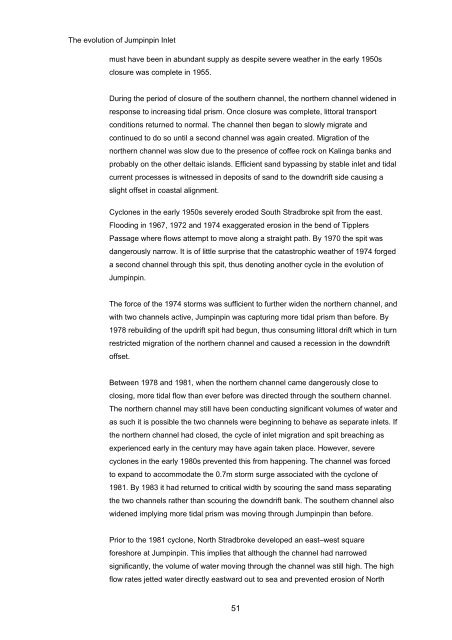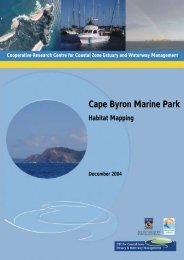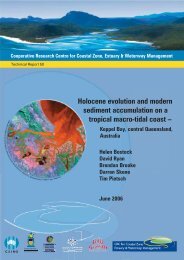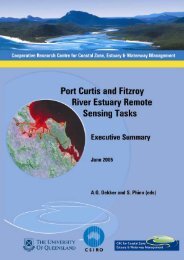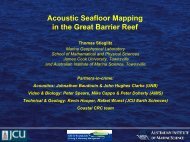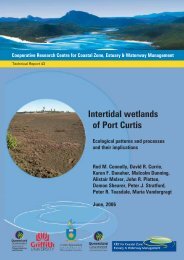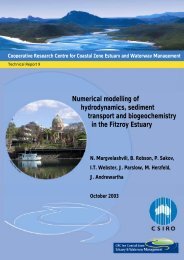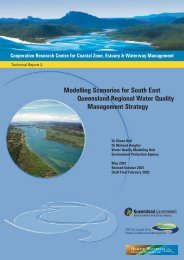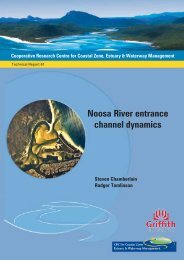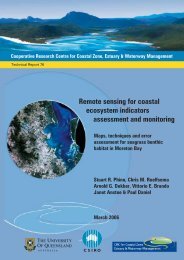The evolution of Jumpinpin Inlet - OzCoasts
The evolution of Jumpinpin Inlet - OzCoasts
The evolution of Jumpinpin Inlet - OzCoasts
You also want an ePaper? Increase the reach of your titles
YUMPU automatically turns print PDFs into web optimized ePapers that Google loves.
<strong>The</strong> <strong>evolution</strong> <strong>of</strong> <strong>Jumpinpin</strong> <strong>Inlet</strong><br />
must have been in abundant supply as despite severe weather in the early 1950s<br />
closure was complete in 1955.<br />
During the period <strong>of</strong> closure <strong>of</strong> the southern channel, the northern channel widened in<br />
response to increasing tidal prism. Once closure was complete, littoral transport<br />
conditions returned to normal. <strong>The</strong> channel then began to slowly migrate and<br />
continued to do so until a second channel was again created. Migration <strong>of</strong> the<br />
northern channel was slow due to the presence <strong>of</strong> c<strong>of</strong>fee rock on Kalinga banks and<br />
probably on the other deltaic islands. Efficient sand bypassing by stable inlet and tidal<br />
current processes is witnessed in deposits <strong>of</strong> sand to the downdrift side causing a<br />
slight <strong>of</strong>fset in coastal alignment.<br />
Cyclones in the early 1950s severely eroded South Stradbroke spit from the east.<br />
Flooding in 1967, 1972 and 1974 exaggerated erosion in the bend <strong>of</strong> Tipplers<br />
Passage where flows attempt to move along a straight path. By 1970 the spit was<br />
dangerously narrow. It is <strong>of</strong> little surprise that the catastrophic weather <strong>of</strong> 1974 forged<br />
a second channel through this spit, thus denoting another cycle in the <strong>evolution</strong> <strong>of</strong><br />
<strong>Jumpinpin</strong>.<br />
<strong>The</strong> force <strong>of</strong> the 1974 storms was sufficient to further widen the northern channel, and<br />
with two channels active, <strong>Jumpinpin</strong> was capturing more tidal prism than before. By<br />
1978 rebuilding <strong>of</strong> the updrift spit had begun, thus consuming littoral drift which in turn<br />
restricted migration <strong>of</strong> the northern channel and caused a recession in the downdrift<br />
<strong>of</strong>fset.<br />
Between 1978 and 1981, when the northern channel came dangerously close to<br />
closing, more tidal flow than ever before was directed through the southern channel.<br />
<strong>The</strong> northern channel may still have been conducting significant volumes <strong>of</strong> water and<br />
as such it is possible the two channels were beginning to behave as separate inlets. If<br />
the northern channel had closed, the cycle <strong>of</strong> inlet migration and spit breaching as<br />
experienced early in the century may have again taken place. However, severe<br />
cyclones in the early 1980s prevented this from happening. <strong>The</strong> channel was forced<br />
to expand to accommodate the 0.7m storm surge associated with the cyclone <strong>of</strong><br />
1981. By 1983 it had returned to critical width by scouring the sand mass separating<br />
the two channels rather than scouring the downdrift bank. <strong>The</strong> southern channel also<br />
widened implying more tidal prism was moving through <strong>Jumpinpin</strong> than before.<br />
Prior to the 1981 cyclone, North Stradbroke developed an east–west square<br />
foreshore at <strong>Jumpinpin</strong>. This implies that although the channel had narrowed<br />
significantly, the volume <strong>of</strong> water moving through the channel was still high. <strong>The</strong> high<br />
flow rates jetted water directly eastward out to sea and prevented erosion <strong>of</strong> North<br />
51


